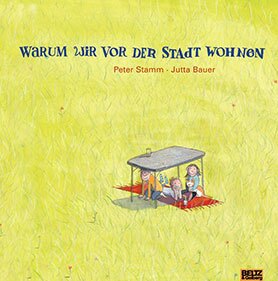Peter StammJutta Bauer
Warum wir vor der Stadt wohnen
[Why we live outside town]
- Beltz & Gelberg Verlag
- Weinheim Basel 2005
- ISBN 3-407-79875-X
- 42 Pages
- Publisher’s contact details
Peter Stamm
Warum wir vor der Stadt wohnen
[Why we live outside town]
This book was showcased during the special focus on Chinese (2005 - 2006).
Sample translations
Review
If someone asks us „where can you live?“, most of us are bound to be able to think of a couple of nice dwellings straight off; maybe a couple of less pleasant ones, too. In his book, Peter Stamm sends a family who is searching for the ideal place to live to the most unusual and fantastical places. A double page is devoted to each place, with a short text accompanied by a large illustration by Jutta Bauer, whose expressive and always highly individual images precisely reflect Stamm’s words. The search for the best place to live is a journey through the imagination. The first and last stories do, it’s true, concern the „perfectly normal“ houses the family lives in, but in between, they find themselves in such places as „in the cinema“, „in the sea“, or even „nowhere“.
Peter Stamm’s texts unsettle the reader – not only because of the unusual selection of places he makes the family live in, but also because of the carefully constructed episodes whose inner connections aren’t always obvious and which are thus thought- (or discussion-) provoking. The texts always begin with a description of what the individual family members were doing „when we (for example) were living in the cinema, in the sea, or in Auntie’s violin“; how the other people behaved there, and what the most striking features were. In the trolleybus „it stank of diesel and sweat the whole day long“; in the hotel „we heard a loud knocking noise coming from the heating pipes“; and on the moon, everything was „full of dust, though there wasn’t very much of an ‚everything’, as we’d left all our things behind on earth.“
Peter Stamm satisfies children’s fondness for recognisable patterns in a story by ending each one with its own particular play on words and numbers. This is still quite „harmless“ in the first story: „The father read four newspapers, the mother bought three chairs, the grandmother knitted two pairs of stripy socks for each of us, and the grandfather lost one pair of sunglasses.“ When the family is living in the rain, this is what we are told: „The brother learnt to recite the names of the four seasons, the mother prayed to the Holy Trinity for the rain not to stop, and the grandfather had double vision. Then the father stepped in the puddle, and „there was only a single image left.“
The combination of adherence to strict form guidelines and the surprising, sometimes surreal, content in the concluding lines, all of which count backwards, allow the readers and listeners to invent their own versions and compare them with the author’s. Every text, however, ends with one definitive reason why they unfortunately can’t live in that particular place, and then comes the next chapter, where they’re trying out another new place to live.
The detail-packed illustrations by Jutta Bauer could equally well be the starting point for this unusual voyage of discovery. Even children who can’t yet read will find plenty to discover either on their own or together with an adult.
The imaginative exploration of these places, then, provides endless scope for children to ask questions and come up with their own interpretations. You’re fully involved in the story and have even been forced to revise your own thinking by the time the family – on their eighteenth attempt – find their little house outside the town, where they „will probably stay for a long time to come.“

Peter Stamm’s texts unsettle the reader – not only because of the unusual selection of places he makes the family live in, but also because of the carefully constructed episodes whose inner connections aren’t always obvious and which are thus thought- (or discussion-) provoking. The texts always begin with a description of what the individual family members were doing „when we (for example) were living in the cinema, in the sea, or in Auntie’s violin“; how the other people behaved there, and what the most striking features were. In the trolleybus „it stank of diesel and sweat the whole day long“; in the hotel „we heard a loud knocking noise coming from the heating pipes“; and on the moon, everything was „full of dust, though there wasn’t very much of an ‚everything’, as we’d left all our things behind on earth.“
Peter Stamm satisfies children’s fondness for recognisable patterns in a story by ending each one with its own particular play on words and numbers. This is still quite „harmless“ in the first story: „The father read four newspapers, the mother bought three chairs, the grandmother knitted two pairs of stripy socks for each of us, and the grandfather lost one pair of sunglasses.“ When the family is living in the rain, this is what we are told: „The brother learnt to recite the names of the four seasons, the mother prayed to the Holy Trinity for the rain not to stop, and the grandfather had double vision. Then the father stepped in the puddle, and „there was only a single image left.“
The combination of adherence to strict form guidelines and the surprising, sometimes surreal, content in the concluding lines, all of which count backwards, allow the readers and listeners to invent their own versions and compare them with the author’s. Every text, however, ends with one definitive reason why they unfortunately can’t live in that particular place, and then comes the next chapter, where they’re trying out another new place to live.
The detail-packed illustrations by Jutta Bauer could equally well be the starting point for this unusual voyage of discovery. Even children who can’t yet read will find plenty to discover either on their own or together with an adult.
The imaginative exploration of these places, then, provides endless scope for children to ask questions and come up with their own interpretations. You’re fully involved in the story and have even been forced to revise your own thinking by the time the family – on their eighteenth attempt – find their little house outside the town, where they „will probably stay for a long time to come.“
Translated by Allison Brown

By Heike Friesel
